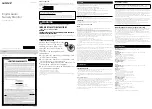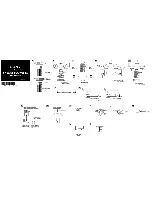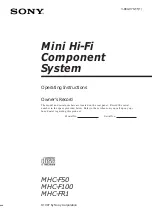
10
When all frost is melted, dry the interior of the refrigerator with
a clean cloth. Replace all food and start the refrigerator by
pressing the ON/OFF button (1) to DOWN position.
NOTE: On these models the drip tray/cup is on the rear side
of the refrigerator. (See FIG. 1)
Put the plastic drain tube in a watertight bucket or container
(access through louvered service panel on the outside of the
vehicle). As the frost melts, the water will flow into the
container. When all the frost has melted wipe up the excess
moisture and empty the accumulated water from the bucket.
Replace the drain tube to its original position.
E. CLEANING
Cleaning the refrigerator is usually done after it is defrosted
or put into storage. To clean the interior liner of the refrigera-
tor, use lukewarm weak soda solution. Use only warm water
to clean the finned evaporator, ice trays and shelves.
NEVER use strong chemicals or abrasives to clean these
parts as the protective surfaces will be damaged. It is
important to always keep the refrigerator clean.
F. SHUT-OFF (STORAGE PROCEDURE)
Shut off the refrigerator by pressing the main power ON/OFF
button to the UP (OFF) position.
If the refrigerator will not be in operation for a period of weeks,
it should be emptied, defrosted, cleaned and the doors left
ajar. The ice tray should also be dried and kept outside the
cabinet.
G. CLIMATE CONTROL
During the summer months of high temperatures and
humidity, the metal frame between the freezer and fresh
food compartments may have water droplets forming. The
number of water droplets will increase if the vehicle isn't
air conditioned during these months.
This refrigerator comes standard with a 12 volt (DC)
climate control that will evaporate the water droplets when
they form.
To have this climate control on, you position the switch
(See "C", Fig. 10) located beneath the top decorative
strip that houses the control panel to ON. The climate
control can be left on continuously or only used when
temperatures require it.
NOTE: The climate control will draw 12 volts DC power
continuously when in the ON position. It should be turned
OFF when a charging source is not available.
Most LP gas appliances used in recreational ve-
hicles are vented to the outside of the vehicle. When
parked close to a gasoline pump, it is possible that
the gasoline fumes could enter this type of appli-
ance and ignite from the burner flame, CAUSING A
FIRE OR AN EXPLOSION.
FOR YOUR SAFETY, when refueling, shut off all LP
gas appliances which are vented to the outside.
1. REFRIGERATOR REMOVAL
Before working on the refrigerator, make sure the AC voltage
and DC voltage leads are disconnected. Shut off the gas
supply. Disconnect the gas supply line. Cap the gas supply
line, loosen the screws anchoring the refrigerator to the
enclosure and slide the refrigerator out of the compartment.
Replacement is the reverse of removal. Check all connec-
tions for gas leaks. Refer to
Section A, Item 1 to 12 of
Installation Instructions.
2. PERIODIC MAINTENANCE
To keep your Dometic refrigerator operating efficiently and
safely, periodic inspection and cleaning of several compo-
nents once or twice a year is recommended.
A. It is important to keep the area at the back of the
refrigerator clean. Check the lower vent, upper vent and
area between these openings for any obstructions such
as bird/insect nests, spider webs, etc. Clean the coils on
the back of the refrigerator. Use a soft bristled brush to
dust off the coils.
It is important to keep the refrigerator area free from
combustible material, gasoline and other flammable
vapors or liquids.
B. Check all connections in the LP gas system (at the back
of the refrigerator) for gas leaks. The LP gas supply must
be turned on. Apply a noncorrosive bubble solution to all
LP gas connections. The appearance of bubbles indi-
cates a leak and should be repaired immediately by a
QUALIFIED SERVICEMAN WHO IS FAMILIAR WITH
LP GAS SYSTEMS AND REFRIGERATORS.
DO NOT USE A FLAME TO CHECK FOR GAS LEAKS.
C. Check the control system by connecting/disconnecting
120 volt AC power. Compare the operation with the
operation described in
Section C. Operation Instructions.
NOTE: The following maintenance is required once or twice
a year, but should only be done by a qualified serviceman
who is familiar with LP gas systems and refrigerators.
D. The LP gas pressure should be checked and the main
regulator readjusted if pressure is incorrect. The correct
operating pressure is 11 inches of water column. The
correct place to take the LP gas pressure is at the test
port just ahead of the burner jet. (See FIG. 12).
E. Inspect the flue baffle. It should be reasonably clean and
SECTION D.
MAINTENANCE & SERVICE






























